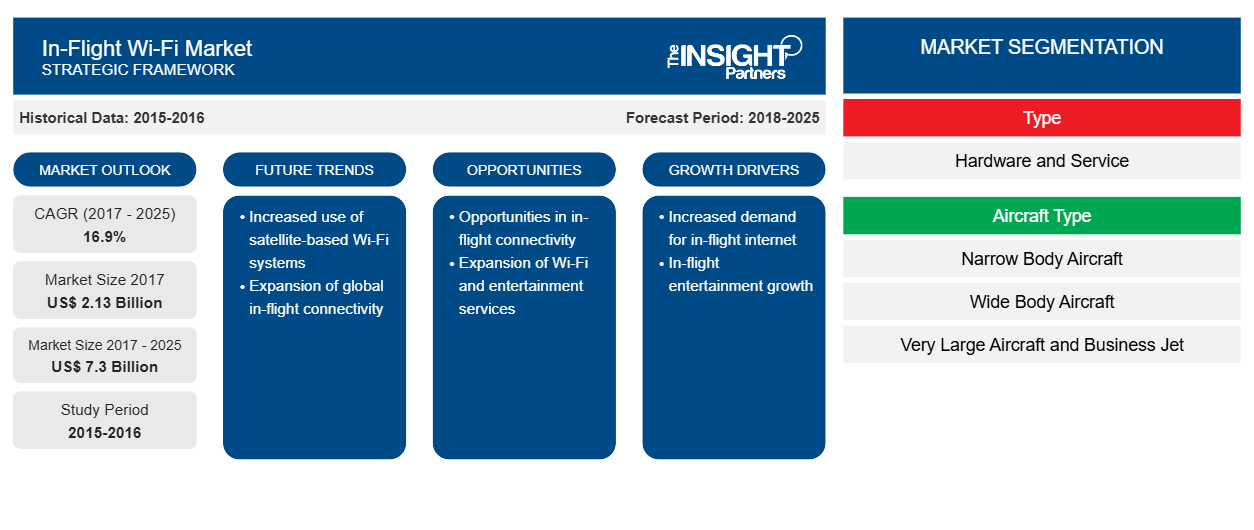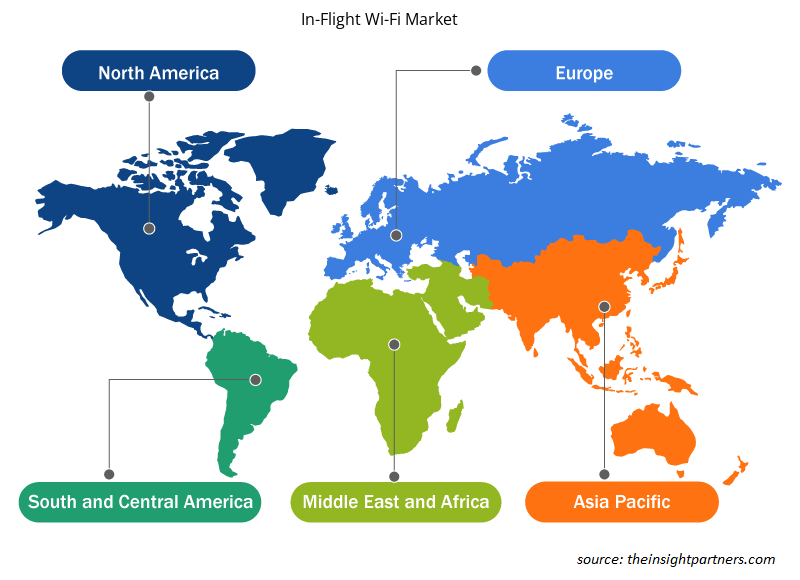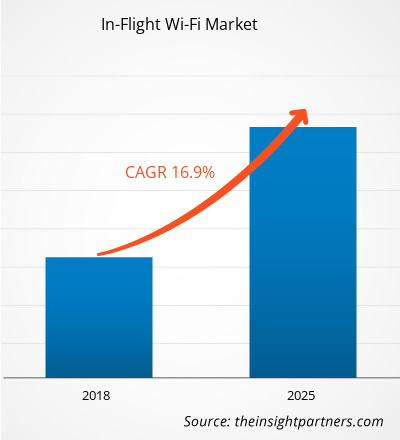The in-flight wi-fi market was valued at US$ 2.13 billion in 2017 and is projected to reach US$ 7.30 billion by 2025; it is expected to grow at a CAGR of 16.9% during 2018–2025.
In todays “always on” culture, particularly the business traveler’s anticipation for the airline companies to embed digital technologies including In-Flight connectivity options amid aircrafts is burgeoning. The epical growth in usage of electronic devices from passengers has also evidently raised the demand for on board connectivity, especially for long haul flights. Furthermore, as the airline companies themselves are under a pressure to derive additional revenue streams expected to significantly, the In-Flight connectivity (Wi-Fi) is considered to be a win-win strategy as majority passengers globally are willing to pay for the high-speed internet connection while travelling by air.
Smaller airlines have also started offering Wi-Fi services in order to attract more customers and compete with large global airlines. In coming years, In-Flight Wi-Fi is expected to deliver higher speed. For instance, a company such as Inmarsat in collaboration with other companies is working on a high-capacity satellite Wi-Fi network supported by ground towers. It is expected to provide a consistent high bandwidth broadband service in the air. Gogo Inc., one of the major players in In-Flight Wi-Fi market has assured to reach the speed up to 70 Mbps using dual Ku-band antennas that connect to the satellite. Moreover, the satellite In-Flight Wi-Fi technology is expected to deliver up to 70 Mbps speed with upgraded antennas. While air to ground technology, providers is expected to meet In-Flight Wi-Fi speed up to 100 Mbit/s. With the technological improvement in the air to ground and satellite connectivity, In-Flight Wi-Fi is projected to offer better speed, improved experience, with optimal cost. The market for In-Flight Wi-Fi market is expected to flourish in coming years owing to the higher connection speed and increase in the number of routes covered.
Customize This Report To Suit Your Requirement
You will get customization on any report - free of charge - including parts of this report, or country-level analysis, Excel Data pack, as well as avail great offers and discounts for start-ups & universities
In-Flight Wi-Fi Market: Strategic Insights

- Get Top Key Market Trends of this report.This FREE sample will include data analysis, ranging from market trends to estimates and forecasts.
You will get customization on any report - free of charge - including parts of this report, or country-level analysis, Excel Data pack, as well as avail great offers and discounts for start-ups & universities
In-Flight Wi-Fi Market: Strategic Insights

- Get Top Key Market Trends of this report.This FREE sample will include data analysis, ranging from market trends to estimates and forecasts.
Market Insights–In-Flight Wi-Fi Market
In-Flight retail partnerships
Currently, among the overall travel spending, In-Flight retail accounts for merely around 5%. Owing to better connectivity airlines are now providing their customers with In-Flight retail shopping. For instance, carriers such as Swiss and British Airways permit their passengers to browse and order from their catalogue using smartphone and tablet. In addition, better In-Flight connectivity provides passengers with faster, simpler, and secure shopping experiences which were not possible earlier. Many of the airlines have already started partnering with the retailer, for instance, Air China has partnered with JD.com - one of the online retailer, in order to provide home delivery service and In-Flight shopping. Lufthansa in collaboration with supermarket REWE has announced a project, that permits passengers to order groceries using In-Flight Wi-Fi service which is then transported to the traveler’s home address at their chosen time. Thus, In-Flight Wi-Fi connectivity develop opportunities for retail partnerships and boost the growth of global In-Flight Wi-Fi market.
Type Segment Insights
Based on type, the in-flight wi-fi market is segmented into hardware and service. The hardware market is further broken down as antenna, wireless LAN, access point device, and Hotspot Gateways. On the other hand, the services segment is categorized as integration & implementation service, network planning & design service, support service and other. Currently, the airlines operators are increasingly tending towards the deployment of Wi-Fi systems on their narrow body, wide body, and business jets. This is due to increasing demand for real time In-Flight entertainment, with higher bandwidth. On the other hand, the service market is also escalating at a fair rate over the years, pertaining to the demand for servicing and maintenance of the Wi-Fi systems mounted on the aircrafts, at a regular interval.
Aircraft Type Segment Insights
Based on aircraft type, the in-flight wi-fi market is segmented into narrow body aircraft, wide body aircraft, very large aircraft and business jet. Inflight Wi-Fi systems are installed on all three types of aircraft to enhance customer experience during their travel. Among the three types of aircrafts, narrow body aircrafts are mostly equipped with the Wi-Fi systems, since maximum airlines operating worldwide have huge numbers of narrow body aircrafts in their fleets. For instance, the top airlines which have enabled Wi-Fi systems on 100% of their fleets include Icelandair, SouthWest Airlines and Virgin Airlines. Southwest Airlines have 716 narrow body aircrafts, while Emirates have 256 wide body aircraft which are inflight Wi-Fi enabled. These statistics showcases the demand for Wi-Fi systems among onboard passengers across
Technology Segment Insights
Based on technology, the in-flight wi-fi market is bifurcated into air to ground technology and satellite technology. The air to ground inflight Wi-Fi technology is most widely used technology among the airlines. This is due to simple infrastructure and low cost. On the other hand, satellite technology offers better and high-speed internet, however, is expensive when compared to air to ground technology. This factor is limiting the airlines to opt for satellite based inflight Wi-Fi systems
The market players focus on new product innovations and developments by integrating advanced technologies and features in their products to compete with the competitors.
2018:EchoStar’s Hughes announce enhancement in its JUPITER™ System, by adding rapid In-route Parsing and Prioritization Scheme for providing support for mariti me applications.
2018:Global Eagle Entertainment Inc. announced that All Nippon Airways Trading Co., Ltd. has awarded a three-year contract for in-flight entertainment and content services to Global Eagle.
2018:GOGO’s 2Ku in-flight connectivity solution was selected by Air Canada for its Bombardier CS300 aircraft. With the help of 2Ku in-flight connectivity the Air Canada will provide its customers the capability to work, communicate in-flight, and entertained
In-Flight Wi-Fi Market Regional Insights
The regional trends and factors influencing the In-Flight Wi-Fi Market throughout the forecast period have been thoroughly explained by the analysts at Insight Partners. This section also discusses In-Flight Wi-Fi Market segments and geography across North America, Europe, Asia Pacific, Middle East and Africa, and South and Central America.

- Get the Regional Specific Data for In-Flight Wi-Fi Market
In-Flight Wi-Fi Market Report Scope
| Report Attribute | Details |
|---|---|
| Market size in 2017 | US$ 2.13 Billion |
| Market Size by 2025 | US$ 7.3 Billion |
| Global CAGR (2017 - 2025) | 16.9% |
| Historical Data | 2015-2016 |
| Forecast period | 2018-2025 |
| Segments Covered |
By Type
|
| Regions and Countries Covered | North America
|
| Market leaders and key company profiles |
In-Flight Wi-Fi Market Players Density: Understanding Its Impact on Business Dynamics
The In-Flight Wi-Fi Market is growing rapidly, driven by increasing end-user demand due to factors such as evolving consumer preferences, technological advancements, and greater awareness of the product's benefits. As demand rises, businesses are expanding their offerings, innovating to meet consumer needs, and capitalizing on emerging trends, which further fuels market growth.
Market players density refers to the distribution of firms or companies operating within a particular market or industry. It indicates how many competitors (market players) are present in a given market space relative to its size or total market value.
Major Companies operating in the In-Flight Wi-Fi Market are:
- ECHOSTAR CORPORATION
- GLOBAL EAGLE ENTERTAINMENT INC
- GOGO LLC
- HONEYWELL INTERNATIONAL INC
- PANASONIC AVIONICS CORPORATION
Disclaimer: The companies listed above are not ranked in any particular order.

- Get the In-Flight Wi-Fi Market top key players overview
The Global In-Flight Wi-Fi Market has been Segmented as Follows:
In-Flight Wi-Fi Market – By Type
- Hardware
- Service
In-Flight Wi-Fi Market – By Aircraft Type
- Narrow Body
- Wide Body Aircraft
- Business Jet
In-Flight Wi-Fi Market – By Technology
- Air to Ground
- Satellite
In-Flight Wi-Fi Market – by Geography
North America
- US
- Canada
- Mexico
Europe
- France
- Germany
- Italy
- UK
- Russia
- Rest of Europe
Asia Pacific (APAC)
- China
- India
- South Korea
- Japan
- Rest of APAC
Middle East & Africa (MEA)
- South Africa
- Rest of MEA
South America (SAM)
- Brazil
- Argentina
- Rest of SAM
In-Flight Wi-Fi Market – Companies Profiles
- Echostar Corporation
- Global Eagle Entertainment Inc
- Gogo LLC
- Honeywell International Inc
- Panasonic Avionics Corporation
- Viasat Inc
- Sitaonair
- Thales Group
- Thinkom Solutions Inc
- Kymeta Corporation
- Historical Analysis (2 Years), Base Year, Forecast (7 Years) with CAGR
- PEST and SWOT Analysis
- Market Size Value / Volume - Global, Regional, Country
- Industry and Competitive Landscape
- Excel Dataset
Testimonials
I wish to appreciate your support and the professionalism you displayed in the course of attending to my request for information regarding to infectious disease IVD market in Nigeria. I appreciate your patience, your guidance, and the fact that you were willing to offer a discount, which eventually made it possible for us to close a deal. I look forward to engaging The Insight Partners in the future, all thanks to the impression you have created in me as a result of this first encounter.
DR CHIJIOKE ONYIA, MANAGING DIRECTOR, PineCrest Healthcare Ltd.The Insight Partners delivered insightful, well-structured market research with strong domain expertise. Their team was professional and responsive throughout. The user-friendly website made accessing industry reports seamless. We highly recommend them for reliable, high-quality research services
Yukihiko Adachi CEO, Deep Blue, LLC.Reason to Buy
- Informed Decision-Making
- Understanding Market Dynamics
- Competitive Analysis
- Customer Insights
- Market Forecasts
- Risk Mitigation
- Strategic Planning
- Investment Justification
- Identifying Emerging Markets
- Enhancing Marketing Strategies
- Boosting Operational Efficiency
- Tracking Industry Innovations
- Aligning with Regulatory Trends
Yes! We provide a free sample of the report, which includes Report Scope (Table of Contents), report structure, and selected insights to help you assess the value of the full report. Please click on the "Download Sample" button or contact us to receive your copy.
Absolutely — analyst assistance is part of the package. You can connect with our analyst post-purchase to clarify report insights, methodology or discuss how the findings apply to your business needs.
Once your order is successfully placed, you will receive a confirmation email along with your invoice.
• For published reports: You’ll receive access to the report within 4–6 working hours via a secured email sent to your email.
• For upcoming reports: Your order will be recorded as a pre-booking. Our team will share the estimated release date and keep you informed of any updates. As soon as the report is published, it will be delivered to your registered email.
We offer customization options to align the report with your specific objectives. Whether you need deeper insights into a particular region, industry segment, competitor analysis, or data cut, our research team can tailor the report accordingly. Please share your requirements with us, and we’ll be happy to provide a customized proposal or scope.
The report is available in either PDF format or as an Excel dataset, depending on the license you choose.
The PDF version provides the full analysis and visuals in a ready-to-read format. The Excel dataset includes all underlying data tables for easy manipulation and further analysis.
Please review the license options at checkout or contact us to confirm which formats are included with your purchase.
Our payment process is fully secure and PCI-DSS compliant.
We use trusted and encrypted payment gateways to ensure that all transactions are protected with industry-standard SSL encryption. Your payment details are never stored on our servers and are handled securely by certified third-party processors.
You can make your purchase with confidence, knowing your personal and financial information is safe with us.
Yes, we do offer special pricing for bulk purchases.
If you're interested in purchasing multiple reports, we’re happy to provide a customized bundle offer or volume-based discount tailored to your needs. Please contact our sales team with the list of reports you’re considering, and we’ll share a personalized quote.
Yes, absolutely.
Our team is available to help you make an informed decision. Whether you have questions about the report’s scope, methodology, customization options, or which license suits you best, we’re here to assist. Please reach out to us at sales@theinsightpartners.com, and one of our representatives will get in touch promptly.
Yes, a billing invoice will be automatically generated and sent to your registered email upon successful completion of your purchase.
If you need the invoice in a specific format or require additional details (such as company name, GST, or VAT information), feel free to contact us, and we’ll be happy to assist.
Yes, certainly.
If you encounter any difficulties accessing or receiving your report, our support team is ready to assist you. Simply reach out to us via email or live chat with your order information, and we’ll ensure the issue is resolved quickly so you can access your report without interruption.















The List of Companies
1. ECHOSTAR CORPORATION
2. GLOBAL EAGLE ENTERTAINMENT INC
3. GOGO LLC
4. HONEYWELL INTERNATIONAL INC
5. PANASONIC AVIONICS CORPORATION
6. VIASAT INC
7. SITAONAIR
8. THALES GROUP
9. THINKOM SOLUTIONS INC
10. KYMETA CORPORATION






 Get Free Sample For
Get Free Sample For